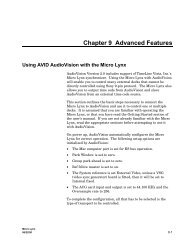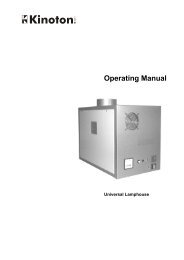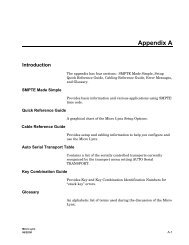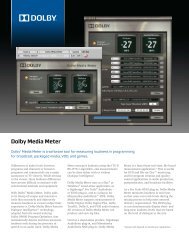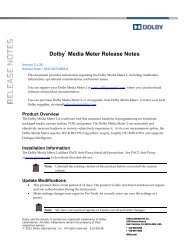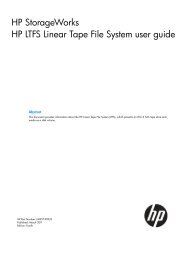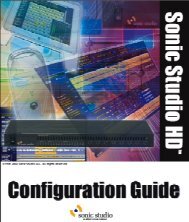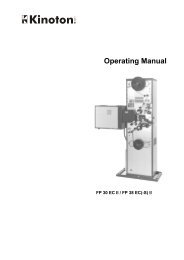Dolby LM100 Broadcast Loudness Meter User's Manual
Dolby LM100 Broadcast Loudness Meter User's Manual
Dolby LM100 Broadcast Loudness Meter User's Manual
You also want an ePaper? Increase the reach of your titles
YUMPU automatically turns print PDFs into web optimized ePapers that Google loves.
Dialogue Intelligence<br />
adjustments, either to the dialogue level parameter value within the <strong>Dolby</strong> Digital or<br />
<strong>Dolby</strong> E stream, or to the source audio levels.<br />
Measurements in the digital domain are referenced to digital full scale, and are expressed<br />
in dBFS.<br />
5.1.5 Measuring Analog Sources<br />
When the selected input is analog, the <strong>LM100</strong> can also provide a suggested value for<br />
dialnorm (by pressing Enter four times from the main status screen). This can be useful<br />
when setting the dialnorm parameter value prior to encoding the program for digital<br />
distribution via <strong>Dolby</strong> E or <strong>Dolby</strong> Digital. This recommended value automates the process<br />
of calculating a dialnorm value when measuring analog sources. The calculated (that is,<br />
derived) value is based on the analog input calibration. See Figure 4‐8.<br />
Analog measurements, by default, are based on the dBu scale, or on a relative scale<br />
(expressed as dBr) if the analog calibration setting is not 0 dBu.<br />
5.1.6 Measuring RF Modulated Sources<br />
When the RF Input is selected and a particular channel is tuned, the default main status<br />
screen indicates the measured loudness value side by side with the unweighted peak value.<br />
Measurements in the RF domain are referenced to 100 percent modulation of the<br />
monophonic sound carrier (25 kHz peak deviation) and are expressed in dBr.<br />
5.2 Dialogue Intelligence<br />
Dialogue Intelligence allows the <strong>LM100</strong> to automatically base ITU‐R BS1770‐1 or Leq(A)<br />
measurements on the portions of the input signal that contain the characteristics of<br />
dialogue. This powerful feature provides users at all skill levels with the capability to easily<br />
quantify the level of dialogue within broadcast programs. By combining Dialogue<br />
Intelligence with extensive logging and alarm capabilities, the <strong>LM100</strong> opens up the<br />
possibility of automated measurement, QC, and control.<br />
Note:<br />
The dialnorm parameter within a <strong>Dolby</strong> Digital bitstream is, after all, also known<br />
as dialogue level, and the term dialnorm is an abbreviation of “dialogue<br />
normalization.” Thus, when the dialnorm value is properly implemented across<br />
multiple programs, the home listener can switch between programs and perceive<br />
the dialogue in each program at the same level.<br />
When you first enable Dialogue Intelligence, the <strong>LM100</strong> takes a few moments to analyze<br />
the input signal before confirming that dialogue is or is not present. During this analysis, a<br />
“listening” icon appears, as shown in Figure 5‐1. When the analysis is complete, either No<br />
Dialogue or a dialogue‐based measurement value appears.<br />
<strong>Dolby</strong> ® <strong>LM100</strong> <strong>Broadcast</strong> <strong>Loudness</strong> <strong>Meter</strong> User’s <strong>Manual</strong> 41




